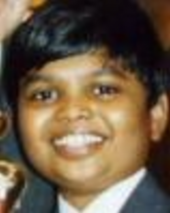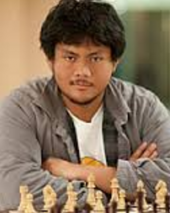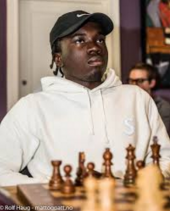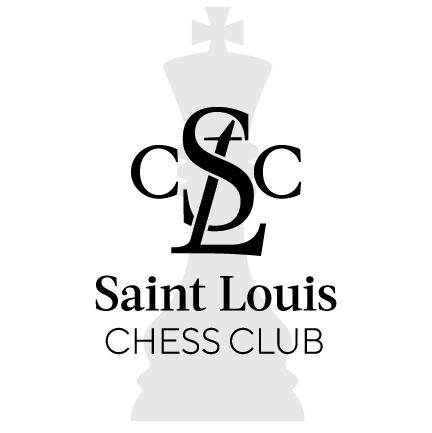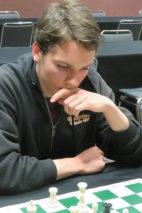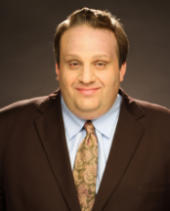Player Bios
Loading...
Bio:
- Eckert is a member of the U.S. federation and his current FIDE rating is 2174. He is currently ranked in the top 350 players in the U.S. and has written a book on his favorite chess openings. Eckert also sits on the board at the Chess Club and Scholastic Center of Saint Louis.
Tag:
Bio:
- Shankar was born in India in 1992. At the age of fourteen he established a national record for the number of international junior chess medals obtained. He is currently rated 2306 FIDE.
Tag:
Bio:
- Burke, rated 2495 FIDE, hails from New Jersey. In 2015, he became the youngest junior to surpass a rating of 2600 FIDE. He is currently the world’s ninth highest rated player under the age of 16.
Tag:
Bio:
- Berczes, born in Hungary in 1990, achieved his International Master norms at the age of 15. In 2007 he helped Hungary win the Under 18 European Team Championship. He earned the Grandmaster Title in 2008, becoming the youngest Hungarian GM at the time. Currently rated 2493 FIDE, he is now studying finance at UT Dallas where he is captain of the chess team.
Tag:
Bio:
- Cemil Can was born in Ankara at 1998. His current FIDE rating is 2495. He has a unique achievement of winning the European Youth Championships for five times. Additionally, he has represented Turkey in the 2012 Istanbul Chess Olympiad.
Tag:
Bio:
- Banawa was born in the Philippines in 1989, and moved to The United States at the age of thirteen. He earned the title of FIDE Master not long after, and is currently rated 2370.
Tag:
Bio:
- Williams, a student at Webster University, has already accomplished many impressive feats over the board. He earned his IM and FM norms while still in High School and then went on to win The 2013 he won the US Junior Open. He is currently rated 2326 FIDE.
Tag:
Bio:
- Lopez, born in Spain in 1993, obtained his FM title at the age of 13 and became a Grandmaster in 2014. He currently studies Software engineering at The University of Texas at Dallas.
Tag:
Bio:
- Gorovets, born in Belarus, currently holds a rating of 2531 and is one GM norm away from earning the Grandmaster title. He studies Geography and competes for the chess team at Texas Tech University in Lubbock.
Tag:
Bio:
- FM Lefong Hua is a chess coach and trainer from Montreal, Canada. Lefong excelled at chess as a child, most notably finishing 5th place in the 1992 World Youth Chess Championships alongside future top GM’s Aronian, Grischuk, and Bacrot. Lefong recently achieved his first IM norm in Saint Louis during the 2016 Saint Louis Autumn Invitational. His current FIDE rating is 2333.
Tag:
Bio:
- Vitaly Neimer is an International Master from Israel which was born in Russia in 1988. He came to the U.S. to join the prestigious Webster SPICE national chess champion team. He is also a two time Israeli national champion and a certified chess trainer. Vitaly is a former IDF soldier and aspires to become a CPA. His Current FIDE rating is 2356 and he is ranked among the top 100 players in Israel.
Tag:
Bio:
- Young is part of the Philippines federation where he is ranked in the top 50 players. His current FIDE rating is 2318. He is two-time MVP for the Chicago Blaze in the United States Chess League.
Tag:
Bio:
- Aaron is from a small town of 4000 on the southwest Oregon coast. Despite the travelling obstacles and not learning the game until 11 years of age, he was able to climb to over 2300 FIDE with no formal coaching in under eight years. Aaron has dominated the top spot on the Oregon juniors list for three years straight before moving to St. Louis to study chess at Webster University. Aaron’s greatest achievement is making 5.5/9 in the 2016 SPICE Cup and gaining his first International Master norm. His current FIDE rating is 2380.
Tag:
Bio:
- Brooks is part of the U.S. federation where he is ranked in the top 100 players. His current FIDE rating is 2405.
Tag:
Bio:
- Colas was born in 1998 and is ranked in the top 150 players in the U.S. His current FIDE rating is 2328. He holds the record as youngest-ever African-American Chess Master (preceded by Justus Williams); 2013 New York State High School Chess Champion; USCF All-American: 2010-2013.
Tag:
Bio:
- Nikhil Kumar is a FIDE Master from Miami, Florida. He was born in 2004 and played in his first chess tournament in November 2012. In less than four years after his first tournament, Nikhil won the 2016 U-12 World Chess Championship in Batumi, Georgia. More recently, he won the Open section of the 2016 National Chess Congress in Philadelphia. His current FIDE rating is 2479. In the U-14 age group, he is currently ranked 2nd in the US and also 2nd worldwide.
Tag:
Bio:
- Tatev Abrahamyan started playing chess at eight after her father took her to the 1996 Chess Olympiad in Yerevan, Armenia. Currently the third highest rated female in the U.S., she has represented the United States in four Olympiads and two World Team Championships since 2008.
Tag:
Bio:
- When he is not playing chess, Nicolas is a karate Black Belt and an avid soccer player, normally playing as a midfielder. 2012 started Nicolas’ chess achieves when he became U12 National Champion in the USCF/Chess.com invitational championship. He has since been a member of the All-American Chess Team.
Tag:
Bio:
- GM Finegold’s first major tournament win came in 1989 when he finished in a first-place tie at the U.S. Junior Closed Championship. In 1991, Finegold won his first major, international, Swiss-paired tournament in Antwerp, Belgium at just 21 years old. In 1993, was awarded the Samford Chess Fellowship. Finegold has offered outstanding commentary for several of the Club’s elite events.
Tag:
Bio:
- Awonder is well-known in the chess community for the record-shattering pace at which he continues to improve. A week after his eighth birthday, Awonder became the youngest chess expert in U.S. history – breaking the record previously held by Sam Sevian. He also broke the record for youngest national master in U.S. history 17 days before his 10th birthday. Awonder holds the distinction for the youngest-ever player to beat an international master and the youngest American to beat a grandmaster in a standard time control. At the age of 9 years and 111 days, Awonder defeated GM Larry Kaufman in the Washington International – breaking the record previously held by Fabiano Caruana. Awonder is entering the tournament a two-time world champion having earned gold medals in the Under-8 World Youth Chess Championship in Brazil (2011), and later the Under-10 World Youth Chess Championship in the United Arab Eremites (2013).
Tag:


